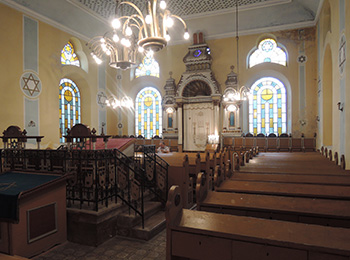Like the echoes of the Big Bang, the Holocaust continues to resonate in this drab, rubble-strewn northeastern Romanian town. With a prewar community that peaked at 13,000, Jews once formed fully one-quarter of the population and included the mighty Satmar chassidic dynasty.
While it’s difficult to assess the total number of Jews left in Romania – it’s thought to be between 4,000 and 5,000 – here in the town called Szatmar (in Hungarian), the head of the community, Nicolae Decsei, is specific: there are 104 Jews here today, and just two families can trace Jewish lineage on both sides. The rest have intermarried.
Of the known Jewish members of the Szatmar community, about 30 consider themselves religious enough to attend regular synagogue services. Three are Holocaust survivors who returned home.
At 74, Decsei is among the youngest.
There might be more Jews, but they are “hidden,” says Decsei, a serious but affable former lawyer and army officer. “They don’t want to be known.”
It’s a rather sad state of affairs for the North American visitor, who encounters two Jewish cemeteries here: the Orthodox, with some 3,000 graves, and the “Neolog” (also known as the Status Quo cemetery), which holds about 900.
At the former (where my mother’s father is buried), the scene is probably a repeat of half-forgotten Jewish graveyards all over eastern Europe: many tombstones are crooked, toppled or faded and chipped to unreadability. Moss and mould play havoc. The brush is knee-high in places, the ground heaves.

The oldest tombstones date from the first half of the 19th century. One of the grandest graves belongs to the first wife of Joel Teitelbaum, the late Satmar Rebbe.
The cemeteries’ caretaker, Ioan Bojani, who apprenticed as a tombstone maker at age 16, does the best he can with limited funds and resources. But, he says, the families of the dead could be long gone themselves. With a sweep of his arm, he notes that there are a total of 126 Jewish cemeteries in this region of Transylvania.
Jews first settled here around 1700, and the community grew to have eight synagogues, a yeshiva and a Hebrew printing house. The town was annexed to Hungary in 1940, and following Nazi Germany’s invasion of Hungary in March 1944, a ghetto was established. Soon after that, more than 18,000 Jews were deported from Szatmar and surrounding communities to Auschwitz. Very few returned.
Apart from the cemeteries, all that’s left are two shabby synagogues, located next door to each other. The Great Synagogue on Decebal Street was finished in 1892 and modelled on the synagogue in the larger city of Oradea, some 130 kilometres southwest. Unused for 40 years, it re-opened a few years ago as a venue for cultural events, including well-attended klezmer concerts.
The only remaining working shul is the musty, creaky Saar Ha Torah Synagogue, opened in 1927, just a hop over. Chairs for services, split between men and women, are set up in the lobby, where a sign on the wall attempts to discourage chatter: “Only God speaks in the synagogue.”
Between the two synagogues is an impressive new Holocaust monument paying tribute to local victims, while on the wall of the working synagogue, names of the dead may be engraved into stone at a cost of one Euro per letter.
Decsei, who was born in the war-time Romanian-administered territory of Transnistria, which for Jews was little more than an open-air concentration camp, notes that there was a third synagogue destroyed in 1965. Today, there’s a four-level police station on the site.
A rabbi visits Szatmar from the Romanian capital, Bucharest, or the Hungarian city of Debrecen, but rarely, Decsei says. There are just four rabbis in all Romania, he adds with some sadness in his eyes.
On the other hand, there’s little anti-Semitism today in a country with a long history of it. Decsei says it’s common knowledge that the late dictator Nicolae Ceausescu sold Jews to Israel. But, he adds, Romania was the sole Eastern Bloc country not to sever relations with Israel following the 1967 Six Day War.
Asked about the Szatmar Jewish community’s future, Decsei shrugs.
